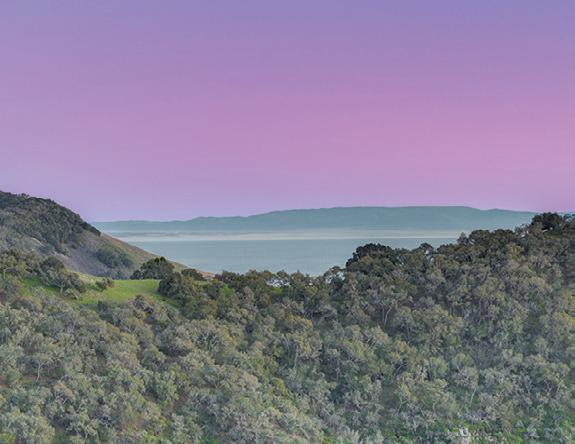



Copy editor Michael Chaldu community writer
Camille DeVaul LAYOUT



Neil Schumaker Anthony Atkins Ad Design Jen Rodman Ad Consultant





Copy editor Michael Chaldu community writer
Camille DeVaul LAYOUT



Neil Schumaker Anthony Atkins Ad Design Jen Rodman Ad Consultant










Spring is a time of renewal, growth, and transformation. As the rain finally lessons, and the flowers begin to bloom, we are reminded that change is inevitable, and embracing it is key to living a fulfilling life. It's true, change can be difficult, and often times, we resist it. But, it is only when we embrace change and the season of spring that we truly grow and thrive.





Dana McGraw Administrator Cami Martin office@13starsmedia.com Mary Foppiano Betty Hartig



Kathy Mastako Rick Cohen John Salisbury

Embracing spring means letting go of the old and making room for the new. Just as the trees shed their leaves in the fall, we, too, must let go of what no longer serves us. This may be a job, a relationship, or even an old way of thinking. As we let go of the old, we make space for new opportunities and experiences to come into our lives. Change can be scary, but it's important to remember that it's also necessary for growth. Just as a seed must be planted and watered before it can grow into a beautiful flower, we, too, must go through periods of discomfort before we can reach our full potential. Embracing this change means accepting that discomfort and using it as an opportunity to learn and grow.
Patience is key when it comes to embracing change. Just as it takes time for the flowers to bloom, it takes time for us to adjust. It's important to be patient with ourselves and others as we navigate this season of transformation. Change can be overwhelming, but by taking it one step at a time and being patient with ourselves, we can make the transition smoother.
Embracing the season of spring also means cherishing the time we have with our loved ones. As we watch our kids grow and change, it's important to be present and in the moment. We must appreciate the time we have with them and create lasting memories that we can look back on with joy and fondness.
As I watch my boys grow, I am filled with a mix of emotions. Their achievements and milestones bring me immense joy and pride, but I am also saddened by the fleeting nature of childhood and the preciousness of time.

In the midst of the hustle and bustle of daily life, it can be all too easy to forget to appreciate the little moments with our kids. However, by consciously choosing to be present with them and savoring these moments, we can make the most of this special time. It may not always be easy, but by embracing it and facing it head on, we open ourselves up to new opportunities and experiences. So, as we welcome the spring and Easter season, let's take a moment to embrace all that it brings with it and continue to grow and thrive in this life and stand up for all that you cherish and hold dear. We wish you a delightful season filled with hope, joy, and renewal. Please enjoy this issue of Avila Beach Life.

"The greatness of a community is most accurately measured by the compassionate actions of its members." - Coretta Scott King
Greetings, Fellow Avilones. As the saying goes, “spring has sprung,” and we have headed into a new season. Winter was sort of a lost cause due to colder, windier and wetter than usual weather, though a strong case can be made that the rain was badly needed to replenish our lakes and reservoirs. It’s just a shame that so much damage occurred throughout SLO County. Some of the breaking news for this month’s column comes from Julie Andrews-Scott, who has informed me that this year’s Avila Farmers’ Market will operate each Friday from May 5 through August 25. This activity has become quite popular and was first launched by Julie as a senior project while attending Cal Poly. Congratulations, Julie. And we also received word from South County Transit that the Free Avila Trolley will run from May 5 through September 2. Rides remain free as the “Foundation” continues to help subsidize Trolley operating costs.
Just a few days ago, the “Foundation” successfully hosted the latest rendition of our Avila History series. This time local historian
Pete Kelley took us through a slide show tour of Avila’s Front Street in the old days. It was stunning to see how the area has evolved and that even way back then, the crowds visiting our beach were enormous. We knew this free event would be popular when it “sold out” within eight hours of being posted, so we added a repeat performance for the following night, which also sold out. In addition to the slide show, the “Foundation” treated attendees to a tasty dessert, and the Civic Association set up a no-host bar to help raise funds for the Community Center. Rounding out the evening was a drawing for some door prizes, including three framed old-time photos donated by Richard and Kathy Zacky, along with a few items of Avilone “swag.”
As we prepared for the Avila History event, I couldn’t help but reflect on my own time in the area. My wife, our cat and I moved from Irvine in 1989 and initially landed in Los Osos. The two of us having met as Irvine tennis players, it didn’t take long after our move to learn that the best competition in the area was at the Avila Bay Athletic Club. It was sometime in early 1990 that we ventured out to the Club, liked what we saw, and joined. Come that first summer in 1990, we also discovered that while Los Osos was shrouded in fog, the summer sun was always shining in Avila. “Let’s move there! Easier said than done. Back then San Luis Bay Estates had



only two residential developments, and one was for people aged 55+ years. We were too young. Homes in downtown Avila were rarely seen on the market, and sales seemed to occur only via word of mouth. So, in 1995 we ended up in Pelican Point, stretching our budget for the slightly more than $200k price tag. I’m not complaining, but homes in PP have been selling recently in the $1m range. Sheesh.
Looking back so much has changed. Many of the people in our neighborhood back then have since passed away. Same with the pets we grew so fond of. The Avila Bay Club back in the 90s was truly an adult sanctuary. It was a serene place to hang out after tennis, with very few kids around. As the area developed and began attracting families, the Bay Club transitioned to become family oriented. No more quiet days around the pool. Back then, the Avila Beach Golf Resort was just a golf course but has since become more of an event venue and less oriented to the golfing community. Downtown Avila lost its “funky” vibe, having been rebuilt after the” Big Dig.” While the beach town is certainly prettier, the local’s culture has been largely replaced by second homeowners and vacation rental condos. Remember Custom House when it had two dining sections, with the outdoor area that included a
neat aviary? I also recall Fat Cats being open 24 hours to accommodate the fishing industry workers coming in at all hours. Back then, you could get a huge breakfast for five bucks. I am reminded of the song lyrics “Ob-La-Di, Ob-La-Da, life goes on,” as recorded by the Beatles in 1968. Long after we are gone, the next generation will look back on its own memories. They will refer to the good old days of the mid-21st century. It will likely become even more digital. I suspect currency will become a product of the past. I imagine movie theaters will be ancient history. I believe that brick and mortar stores will have all but vanished, and most purchases will be online. Life will be lived by how advanced mobile devices become, experienced through six-inch screens in the palm of the hand. Gas vehicles will be no more, and when power outages occur there will be so many stranded electric vehicles. Progress will always prevail, for better or for worse. All in all, I’m actually pretty glad that I’ve lived when I have. I’m just not well suited to what tomorrow may bring. Oh well, that’s it for now, fellow Avilones. See you at the beach!
I’m writing this note on March 16th, so I don’t know what will happen in the couple of weeks before you read this. What has happened is what could have been easily predicted. After keeping rates at 0% for far too long, the Federal Reserve decided they were going to show who was boss and raise rates until something broke, just like they always do. And something did break. At the time of writing we’ve had two of the 20 largest banks in the country fail and another only survived due to $30 billion deposited by other major banks.*
This banking crisis is much different than the last one in 2008. Back then, it was bad mortgages that caused the problems. Now it’s “guaranteed” treasury securities that banks were required to own that, due to rising interest rates, cratered in value, causing their balance sheets to look upside down. Funny how regulations that seem good at the time come back to haunt later on. ^
So, the fix is for the Fed to inject money into the system via “secured” loans that are supposed to provide some breathing room,^ effectively ending their “tightening,” at least for now. I don’t know the end result. But I do know it’s not going to be smooth sailing. As the old saying goes, is there ever just one cockroach?

Maybe it’s time to look at some new ideas. Perhaps 5+% on fixed accounts and stock market strategies protecting as much as 20% to the downside^* would put some calm into your investing world? Or maybe accounts that have no risk to the downside and are linked to returns in the major indexes? To learn more, please visit our website and/or call for a 15 minute discussion.
*https://www.zerohedge.com/markets/first-republic-bank-shares-crash-exploring-strategic-options
^https://www.zerohedge.com/markets/heres-what-latest-bank-bailout-does-and-why-treasury-quietly-freaking-out ^*Buffered accounts may provide up to 20% protection from index declines while also allowing for 100% participation in the index chosen. Please refer to a product prospectus for specific information on costs, crediting methods and buffer protections.

Iknow that you are all just sitting on the edge of your seats waiting to see the winners of our Cupid Paws Doggie Parade on February 4. However, you will need to wait until next month’s column to see the pictures and hear all the details of this fun event since I wanted to tell you about an event that I know you have been looking forward to attending. COVID pandemic shut down the Community Center for much of the past few years … but we now are happy to announce our annual Spaghetti Dinner/Bingo Night being held on Friday, April 14, from
6 to 8:30 a.m. The dinner will consist of delicious spaghetti and meatballs, spaghetti and marinara sauce, salad, bread, and dessert. We will have soft drinks and beer and wine for sale. There will be a wide variety of bingo prizes for all age groups. I will give you more information next month but hope that you will put April 14 on your calendar now so that you can join us for this family fun night! If you are interested in getting involved with this event or any other upcoming events, please contact me at avilabeachcc@gmail. com or (805) 627-1997.



 By MARY FOPPIANO
By MARY FOPPIANO
Our annual Santa’s Doggie Parade was rained out on December 10. So that we would not disappoint our local pet parents and their adorable furry friends, as well as our many community members who really enjoy our parades, we hosted our first Cupid Paws Doggie Parade on February 4. The very happy-looking handsome pup on the flyer was my lovable little Buddy, who passed away unexpectedly on March 10. I know that we all have to go through loss sometimes in our lives — Whether it is the loss of a family member, friend, or pet. From the first day I adopted Buddy, I knew he was special, and when he was gone, a small piece of my heart was gone. With the help of my best friend, I was able to adopt Rudy, a young Poodle/Maltese dog that was abandoned in Porterville and available at the Spay and Neuter Clinic, a nonprofit organization. Nothing can bring back Buddy, but Rudy is very smart and friendly to everyone, and I feel so very lucky to bring him into our lives.Moving on to our family fun parade, our wonderful judges were Lead Judge Steve Kobliska; Supervisor Dawn Ortiz-Legg with her new family member Frankie, Amy Kuef -
fler, recently retired from the Avila Bay Club, and ABCA President Robin WeedBrown. Petco Arroyo Grande once again donated yummy dog treat bags to all our puppies and community member Karen Blue donated two beautiful raffle baskets. Cheryl Stepaniak donated the use of her stereo system and was the Dalmatian and Bev Aho was the Black Cat. The winners of our Costume Contest were:


• Best Costume: David Bernhardt with Cosette
• Best Dog/Owner Look Alike: Melissa Montgomery with Brody Bones

• Best Holiday Look: Jeri LaMarca with Lexi
• Funniest Costume: Angela Hepburn with Xolo Vente and Isabella Saconi with Gaucho
• Best in Show: Diane Kilfogle and Susan Davis with Tux and Dansby All of our participants were entertaining with their colorful, holiday themed costumes and, hopefully, will be part of our 4th of July Doggie Parade which follows our annual Pancake Breakfast at the Community Center. Hope to see all of you to celebrate Avila Beach and all that we have to offer!
Mary Foppiano Avila Beach Civic Association For Avila Beach Life David Bernhardt with Cosette. Best Dog/Owner Look Alike - Melissa Montgomery with Brody Bones Doggie Raffle Basket by Karen Blue Best in Show - Diane Kilfogle and Susan Davis with Tux and Dansby Best Holiday Look - Jeri LaMarca with LexiOn July 1, 1939, the Lighthouse Service — a 150-year-old institution — ceased to exist. As part of FDR’s Reorganization Plan No. II, it was transferred to the Treasury Department and consolidated with the Coast Guard. At the time of this transition, lighthouse keepers were given several options: they could quit; retire if they were eligible; remain a civilian keeper wearing the United States Lighthouse Service uniform; or transfer into the Coast Guard.
In 1939, Point San Luis had three keepers: head keeper John Robert “Bob” Moorefield, 1st assistant Thomas Guy Lewis, and 2nd assistant Jens Otto Wagner. All three initially chose to remain civilian keepers, even though there were disadvantages to doing so. By staying Civil Service employees, for example, keepers were eligible for the draft; although the United States had not yet entered World War II, it had begun in Europe that September.
Lewis, born in 1892, was a World War I veteran and had been a keeper at several lighthouses before requesting a transfer to Point San Luis in June 1938. It was a promotion for him, from 2nd assistant to 1st assistant, although the promotion came with a reduction in pay. Wagner, born in 1896, transferred to Point San Luis from St. George Reef in August 1938. The two families lived side-by-side at the light station in the two-story duplex built in 1890. They did not get along. At one point in 1940, Lewis reported to Moorefield that Wagner’s wife threatened to slap Lewis in the face and sue him. One of the Lewis kids bullied one of the Wagner boys, once locking him in a chicken house and refusing to let him out.

It must have been a relief to all concerned when Wagner resigned as a keeper in November 1940 to take a position with the War Department in San Francisco. Peace at the light station, at least temporarily, was restored.
Replacing Wagner as 2nd assistant was John Majon “Jack” Stelling. With Stelling’s arrival, the light station’s “Coast Guard era” was officially underway.
Stelling, born in 1919, was an enlisted man, a seaman 1st class; his only previous “keeper” experience was aboard a Coast Guard lightship in San Francisco Bay. He and his wife, June, arrived at the station on December 13, 1940. The couple stayed until June 1941, when, presumably, Stelling was honorably discharged. (He enlisted again in 1944 during World War II, this time in the Navy.)
Stelling was replaced in July 1941 by boatswain’s mate second class Donald Albert “Don” Fiess, the second member of the Coast Guard to be assigned to Point San Luis. Fiess, born in 1918, had just married Ellogene Brown in March 1941. He had previously served at the Farallon Island light station and on the Blunts Reef lightship.
Circa 1940 photograph of Don Fiess
aboard Blunts Reef lightship. Courtesy of Linda Fiess.
Along with civilian keeper Lewis, Fiess served under Bob Moorefield, who had resigned from his civilian position and joined the Coast Guard on July 7, 1941. (Medical care was better for Coast Guard military personnel than for its civilian employees and Moorefield’s wife was ill.)
A little more than a year later, on August 18, 1942, at San Luis Obispo’s Mountain View Hospital, Ellogene Fiess delivered Linda Gayle, the Fiess’s first-born child and the station’s first Coast Guard baby.

It must have been a stressful time to be stationed at the lighthouse. Five months after Don and Ellogene’s arrival, the attack on Pearl Harbor occurred; two-and-ahalf weeks later a Union Oil Company tanker, the Montebello, was torpedoed by a Japanese submarine shortly after it sailed from Port San Luis. The attack occurred about four miles west and two miles south of the Piedras Blancas light station in coastal waters near the town of San Simeon.
As the reader might imagine, much changed at Point San Luis when the United States entered the war.
Immediately after the Pearl Harbor attack, continuous watches were established; blackouts of the Fresnel lens in the lighthouse tower and the lighted buoys in San Luis Bay were common; more military men were assigned to the light station; and in January 1942, a lookout house was erected. It wasn’t until September 1942 that orders were received to resume the normal operation of the light.
Also in September 1942, Moorefield received orders to assume temporary charge of the Avila Section, U.S. Coast Guard Beach Patrol:
‘You will establish a regular patrol between Avila and Point Buchon with the facilities and men now available at Avila. Patrols must be maintained every night from sunset to sunrise, and also during inclement weather or foggy weather when the visibility is zero.
“Under no condition should a man be left alone on patrol, but they should travel in pairs and be stationed fifty feet apart. Rifles will be distributed at a later date, but the main weapon used by the men on beach patrol duty is a police club.
“It is understood that until transportation facilities are furnished this station you will find it difficult to establish a patrol at a distance from the Avila headquarters. But if you contact the Army they might aid you in this matter. However, until the Section is fully established, maintain patrols at such places as can be reached, and also take steps to get the quarters in shape so that when all equipment is received, the patrol can be immediately set up.
“Make a survey of such communication facilities as are available, and divide the beach up into sections so that they can be readily identified, and men can be assigned posts.
“The men on patrol are to report any unusual activities or attempted landings to the Avila Section office; then this information will be transmitted to the nearest Army headquarters. Reports are to be made via the fastest available means.”
No doubt Fiess participated in beach patrol duty along with the other military men stationed at Point San Luis at the time.
Circa 1942 photo of Don, Ellogene, and Linda Gayle Fiess, most likely taken at the time the family was preparing to leave Point San Luis for a new posting. Courtesy of the Point San Luis Light Station archives.

The Lewis and Fiess families left the light station on the tender ship Lupine in November 1942; the Lewises to the Carquinez Strait light; the Fiesses to a new wartime assignment. With Lewis’s departure, the era of civilian keepers at Point San Luis, which had begun in June 1890, was officially over. Only Moorefield remained from the “lighthouse service era,” but he was now a Coastie.
Note: Kathy Mastako is the author of “The Lighthouse at Point San Luis, A collection of short (true) stories.” The book is available at the Point San Luis gift shop and on Amazon, among other outlets. Book proceeds benefit the Point San Luis Lighthouse Keepers, the 501(c) (3) non-profit organization that operates the light station.
 kathy mastako
Board Of Directors
Point San Luis Lighthouse Keeper
Circa 1942 photo of Don, Ellogene, and Linda Gayle Fiess, most likely taken at the time the family was preparing to leave Point San Luis for a new posting. Courtesy of the Point San Luis Light Station archives
kathy mastako
Board Of Directors
Point San Luis Lighthouse Keeper
Circa 1942 photo of Don, Ellogene, and Linda Gayle Fiess, most likely taken at the time the family was preparing to leave Point San Luis for a new posting. Courtesy of the Point San Luis Light Station archives


 By BETTY HARTIG For Avila Beach Life
By BETTY HARTIG For Avila Beach Life
It is April. Furry bunnies and quacking ducks are a favorite to see at Easter time. Avilones can spot dozens of those delightful creatures thriving in their natural habitat. The arrival of the spring season brings an abundance of activity to the estuary and its surrounding grounds. A diversity of waterfowl can be seen swimming, waddling, or pecking in the grasses or reeds. Water birds effortlessly cruise in the creek, often preening to keep feathers nicely oiled, not to be bothered with worries, resembling a carefree lifestyle.
Small, white-billed, dark feathered coots can frequently be observed swimming in Avila’s estuary sector assembled in sizeable groups, referred to as flocks, covers, rafts, and “commotion” or “swarm.” The American coot is a social bird and is the only member of the rail family to live in clusters. Coots are often misidentified as ducks. Take a good look at their rather oversized greenish-colored feet, which are not webbed, but instead designed with lobed toes, allowing them to be powerful swimmers as well as efficiently walk on open ground. Nonetheless, these birds spend most of their time in the water, comfortably living near ponds and golf courses. Coots can fly, but short wings prevent easy take-offs. To compensate, coots must take a running start across the water, rapidly flapping their wings, before becoming airborne.
Sometimes referred to as mud hens, coots are rather noisy, making a variety of calls. It is common to hear vocalization consisting of grunting, croaking, clucking, and squawking, far from a song, but clearly a form of communication that can be used as warning notes. Clattering can be heard both by day and night.
Coots are opportunistic feeders that can dive for food, eat aquatic vegetation, forage on land, and are also omnivorous. A typical pallet may consist of algae and a tasty crustacean, arthropods, or even fish. Coots have
a reputation for sneakily snatching other waterfowl’s meals. The menu is extensive. American coots are not a showy bird. They are plain with little pizzazz, but their chicks are unique. Coot chicks are brightly animated, as if ready for a fashion runway. Their head is a bright red, and neck plumage is a striking furry orange, resembling a flashy shawl, oh la la! What a fashion statement. However, this brilliant display is a bit puzzling. Usually, young wildlife hues are designed with camouflage in mind. Studies indicate the colorful down feathers do serve a purpose. The parent lays six to eight eggs, far more than they can raise. The eggs hatch one by one over a week timespan. The colors are created from carotenoid pigments that the mothers add to their yolks. The more eggs that are laid, the greater the pigment. Therefore, the youngest chicks have a striking contrast with the older chicks. This vivid difference prompts the parents to feed them more. Basically, the newest born and most vulnerable receive higher levels of attention, and extra food, and are most likely to survive. It is nature’s process of elimination done in an interesting way. Preferential treatment at its finest.
The mud hens build nests over water on floating platforms, like a houseboat. Materials gathered for the nest bed are usually living or dead vegetation that is woven into a shallow basket. A hollow interior is lined with smooth material to hold the eggs. Coots breed in spring. Both parents incubate the eggs and look after the nestlings. The father responsibly has the task of leading the chicks to the water. Way to go dads! Young can swim soon after hatching. After four weeks, chicks are ready to dive.
The 1,600-plus residents in Avila are fortunate. It is a beautiful, caring, and friendly community by the sea. The wildlife is a benefit that together we can enjoy and preserve. The American coots are just one of many birds that reside in the estuary water. Take time to observe them in addition to other neighboring waterfowl while you stroll the Bob Jones Pathway.
Now, lace up your shoes. Head out to the trail and see how many birds and ducks you can identify. It is a fee-free nature show, no charge.
 By MARY FOPPIANO
By MARY FOPPIANO
After learning more about Gunner, Maddie, and Misty and their pet parents, I am not sure if I should make them our Pet(s) of the Month or Community Spotlight. However, since I promised to feature our Cupid Paws Doggie Parade winners this month, here goes … Sharon and Bill Smith adopted three Doodles after retiring as a Research Director on NBC’s syndicated entertainment news show, Access Hollywood, and as Water Superintendent for the City of Burbank, respectively. They purchased a weekend home in SLBE while still working and moved to Avila full-time in 2014 and into the Avila Valley in 2019 on over 12 acres.

Gunnar is a 10-year-old black Labradoodle that was re-homed to Sharon and Bill last spring by California Doodle Rescue (californiadoodlerescue.org). They adopted Maddie (tan) and Misty (white) in 2019 when they were both seven years old. They are 11 years old, and Misty, the oldest, will be 12 in April (birthday treats are, of course, welcomed).
Gunnar is a high-energy guy. He loves following all the rules (sit, stay, come, etc.). He would rather lope than walk when responding to

commands. He waits for permission to exit or enter the house. Once, when he had the choice between chasing a fast-moving deer in his year or responding to Sharon, he obeyed her command and returned to her. He loves riding in the car and has his own spot behind the driver. His other love is stealthily watching dogs walk by his yard on the Bob Jones Trail.
Maddie, on the other hand, has never met a rule she felt applied to her. She is a couch potato who is relentlessly cheerful with a constantly wagging tail and she thinks that she is queen for day, everyday … so, obviously, rules do not apply to the queen! She loves riding in their SUV and takes the largest area in the rear to stretch out full-length.
Lastly, there is sweet Misty. She is quiet, loving, thoughtful, and a bit of a flower child who enjoys sleeping in and having breakfast in bed. She does not let her arthritis get her down and enjoys slow, short walks on the Bob Jones Trail with her siblings. She loves riding in the car, as well, and has picked her favorite spot behind the front seat passenger. These are fun-loving loyal pet-family members who are a great addition to our community. Thanks, Sharon and Bill, for sharing the three distinct personalities of your furry friends.
Some agricultural news notes: In the 1800s, 50 percent of Americans were farmers. In 1945, World War II Victory Gardens grew 45 percent of food. In 2020, American growers grew .1 percent of food in backyards. Since the increase of carbon dioxide the earth as a whole has greened by 17 percent. This is Mother Nature’s way of removing CO2 from the planet. The Midwest corn belt, alone, during the growing season, removes as much CO2 and turns it into oxygen as does the Amazon Rain Forest — measured by satellite. There are positive impacts of more carbon in the atmosphere, such as better quality and increased food production.
Higher concentrations of carbon dioxide aid photosynthesis which aids in increased plant growth. Some studies have shown crops utilize water more efficiently, requiring less water, plus colder areas of farming experience longer growing seasons. However, higher carbon dioxide
doesn’t increase all crop production equally across the board because of the different growth metabolisms. Greater for wheat and rice, but not as much for corn or sugarcane.
When plants would reach CO2 saturations of around 550 to 600 ppm, it is calculated that more gas won’t be as beneficial. Right now, the concentration is just over 400 parts per million, as compared to the level before 1950 hadn’t surpassed 300 ppm for hundreds of thousands of years according to NASA. At an increase of 3 ppm per year, the rate in 2015 and 2016, the Earth would reach saturation well before the end of the century. Since 1960, the rate has fluctuated, so it could decrease, the trend generally shows an increasing rate.
Nikki Goddard notes new wine-growing regions are moving both north and south of the equator with climate warming with plantings in Northern and Eastern Europe, as well as parts of North America and Asia. Also, unsuitable regions in established wine-growing areas are going up to plant. As the temperature rises for sea-level vineyards, higher altitude plantings grapes benefit from the intense sunlight that helps ripeness and concentration, and the chilly nighttime temperatures preserve acidity, so the wines are fresh, balanced, and alcohol kept in check. These growers also pick their fruit earlier before the sugar level rises and acidity drops.
The majority of the world’s quality wines are grown between the 30 and 50-degree parallels. Vitis vinifera, which is the species for most of the most popular wines, needs specific growing conditions to be able to survive and does not do well in extreme climate conditions. Too much heat or cold will shut the vines down and stop producing quality fruit which has been proven many times with the wrong grape planting in the wrong place, i.e. Pinot Noir and Chardon-

APR 1-APR 3
NEEDLING EXHIBIT
ART CENTRAL, 1329 MONTEREY ST., SAN LUIS OBISPO
Sun. Noon-4pm, Mon.-Fri. 10am-6pm, and Sat. 10am-5pm
“Needling” exhibit features the cutting edge Fiber Group.
APR 1-APR 3
TIDAL WAVE EXHIBIT
ART CENTER MORRO BAY, 835 MAIN ST., MORRO BAY
Noon-4pm
The exhibit showcases artists who capture the exhilarating sensation of the sea through a wide array of ocean themed artworks, offered in a wide variety of media including the sculptures of Anne Grannis.
APR 1-APR 3
CRITICAL ENCOUNTERS EXHIBIT
BY NIXON BORAH
SAN LUIS OBISPO MUSEUM OF ART, 1010
BROAD ST., SAN LUIS OBISPO

11am-5pm
Beginning with monoprints and
nay in Paso Robles and the Central Valley. Here are some of the nations that are taking advantage of warming: Belgium is raising mostly white wines, including Chardonnay, both oaked and unoaked, and oaked Cote d Beaune-stye of wines. China’s wine drinking is growing faster than any other country and is now the fifth-largest wine market in the world. They grow mainly French grapes like Cabernet Sauvignon, Carmenere, Marselan, and Merlot for the local preference for bold red wines. England has had success with sparkling wines from Chardonnay, Pinot Noir, and Pinot Meunier wine grapes. Ireland is exploring areas in the southeast of the country with Cab and Merlot blends. Japan grew wine grapes 150 years ago but is primarily a sake-drinking country but coming around, especially with Pinot Noir. Their special varietal is Koshu, a French hybrid pink-skinned grape that produces a tart, light, and fresh-tasting white wine. The Netherlands’ winemaking goes back to Roman times but now getting more established. They tend to white wines like Chardonnay, Gewurztraminer, Pinot Blanc and Gries, Riesling, and Solaris, and for reds — Cabernet Franc, Gamay, Pinot Noir and Meunier, and Rondo. Poland had a rich wine culture a thousand years ago, but after medieval times when the weather was warm and beneficial for grapes, it turned cold in the winters, plus political challenges and wine fell out of favor.


Now with the weather changing again, vineyards are being planted, mostly to Rondo and Solaris, with Pinot Noir also getting a nod. In the Scandinavia countries, important markets for fine wines, they are planting humidity-resistant and cold hardy hybrids like Rondo, Solaris, and Riesling. Newfoundland was so warm during the Medieval Warm Period, the
Vikings called it Vineland when they landed and brought back boatloads of grapes to Europe. Growing grapes in South Africa and South America are also moving south taking advantage of the atmospheric warming. So, it is not all bad! I guess you can say we are adapting just like the generations before us going way back have always done, whether ice ages or warming weather. Nothing new here except we seem to be a part of the changing climate, but to what extent is still not certain.
An energy warning, E-Bike batteries have a dark side, with uncontrollable and deadly fires from the lithium-ion batteries that power the bikes and scooters. In a WSJ article, by Scott Patterson, the number of fires is rising rapidly, and fire officials are sending out warnings. Many fires start when people charge overnight, allowing them to overheat. Left in hallways or near doors, the fast-moving fires trap people in their rooms in just minutes.
The chemical fires, which release harmful gases, burn so quickly and hot that they are difficult to put out as in my last column that it took 6,000 gallons of water to put out a Tesla battery fire. Second-hand batteries are the worse. Your laptops, smartphones, and tablets are also liable for a Lithium-ion fire and the cause of the terrible fire and loss of life in a tragic scuba diving boat in the Santa Barbara Channel Islands. Ford just halted production on its F-150 electric pickups after a battery caught fire during a quality check. A common cause is that cracks (most all batteries eventually crack) form between the two electrodes, the cathode and anode, which make them short-circuit and rapidly heat up resulting in a dangerous chain reaction known as a thermal runaway. New cutting-edge batteries are just in the experimental stages.
photography from the 1980s, this exhibition follows the lineage of Nixson Borah’s practice towards his recent digital composites.
APR 1 & EVERY SAT
SLOMA DOCENT TOURS
SAN LUIS OBISPO MUSEUM OF ART, 1010 BROAD ST., SAN LUIS OBISPO
11am-Noon
Gain a deeper understanding of the artwork on view with SLOMA’s docent tours. Join trained guides for interactive and engaging tours of SLOMA’s current exhibitions.
APR 5, 12, 19, & 26
LIVE MUSIC WEDNESDAYS AT PIADINA
PIADINA, 877 PALM ST., SAN LUIS OBISPO 6-9:00pm
Join Piadina outside in the courtyard on Wednesdays. Born and raised in Arroyo Grande, Dustin is a newly emerging local talent - a one-man band, singersongwriter whose style ranges from blues to new country, rock to folk.
APR 7-MAY 1
FLOWERS AND FLUTTERBYS EXHIBIT
ART CENTRAL, 1329 MONTEREY ST. SAN LUIS OBISPO Sun. Noon-4pm, Mon.-Fri. 10am-6pm, and Sat. 10am-5pm “Flowers and Flutterbys” exhibit showcases various art mediums of critters and carnations.
APR 7
FIRST FRIDAY’S CONCERTS
CITY HALL, 6500 PALMA AVE., ATASCADERO 5:30-7:30pm
This Friday will showcase the Stellar Band. The public is encouraged to bring a low-back chair to relax and enjoy the music.
APR 8
SECOND SATURDAY’S AT SLOMA
SAN LUIS OBISPO MUSEUM OF ART, 1010 BROAD ST., SAN LUIS OBISPO
11am-1pm
SLOMA’s Second Saturdays program encourages intergenerational learning and creative expression for children of
all ages. Families are invited to SLOMA’s lawn to learn about the visual arts together using unique activity kits and create an art project inspired by current exhibitions.
APR 8
CAYUCOS EASTER DOG PARADE
CAYUCOS PIER
Noon
For all dog-lovers who support the Mutt Mitt Project throughout Cayucos, the parade benefits the Cayucos Lioness Club who supply the Mutt Mitts for all beach accesses, beaches and downtown Cayucos. The event is free but welcomes donations of $1 per dog and $1 per person.
APR 15
ATASCADERO CITYWIDE YARD
SALE 8am-2pm
Enjoy the Annual Citywide Yard Sale and shop for treasures and bargains at 150+ yard sales all over town! For shopping information, go to atascaderoyardsale. com,
APR 22
EARTH DAY CELEBRATION
LAGUNA LAKE PARK, 504 MADONNA ROAD, SAN LUIS OBISPO 11am-4pm
Community members, families and friends are invited to come out for a day of environmental education, music and fun.
APR 28-30
MORRO BAY KITE FESTIVAL
101 COLEMAN DR., MORRO BAY Daily (visit morrobaykitefestival.org for possible times) Discover








